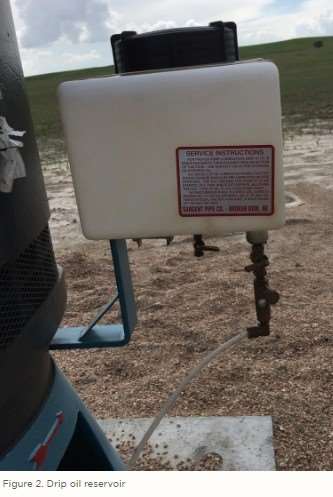By Troy Ingram
Chuck Burr
Aaron Nygren
University of Nebraska-Lincoln
Institute of Agriculture and Natural Resources
CROPWATCH
It has been another wet spring here in Nebraska and farmers challenged to wrap up their spring fieldwork may not have started thinking about their irrigation equipment yet.
Now is a good time to do a quick evaluation of the pumping plant, well, and center pivot to ensure they are in good working order before we have to rely on them during the heat of the summer. Here are a few quick checks you can do to help ensure a successful irrigation season.
Pumping Plants
Electric motors account for about 55% of the pumping plants in Nebraska, according to 2013 NASS Irrigation Survey. They are relatively maintenance-free, but still need to be looked over. It is a good idea to change the oil in the unit every year (Figure 1). Next, open up the junction box and make sure the connectors are tight and have a good ground. Check for frayed wires and damage from rodents.

Figure 1. Oil level indicator on an electric irrigation pump.
Internal combustion engines need quite a bit more attention. Change the engine oil and all filters. Check engine hours and refer to the manufacturer’s service interval on valve adjustments and other service that may be needed such as draining, flushing, and refilling the cooling system. Also, grease and adjust the clutch and drive shaft between power unit and gear head.
If you are running a gas, propane, or natural gas engine, be sure to check the spark plugs and replace as needed.
It’s also a good idea to run the Nebraska Extension App IrrigatePump to see how your pumping plant stacks up against the Nebraska Pumping Plant Criteria. This will give you an idea of the efficiency of the power unit and pump. In the current economic climate we want to be as efficient as possible.
The Pump
The pump is sometimes overlooked. Before you start irrigating in the spring make sure you start the dripper to lube the line shaft bearings (Figure 2). It needs one gallon of drip oil for every 100 feet of depth. Set the dripper for one drip every five seconds. The pump can only take oil so fast and you can't over oil it. Also, make sure the dripper line is attached and the fittings are tight.

Center Pivot
The pivot will take a little more time to go through. Start by checking each tower:
- Check tire pressure and condition.
- Check driveline knuckles for wear.
- Drain water from gearboxes and top off with appropriate gear oil.
- Inspect the tower box and the alignment system.
Next, start up the pump and center pivot system. Once the system is up to pressure, check the system for leaks and to ensure proper operation of the sprinklers. If you find missing or inoperable sprinklers, refer to the system’s sprinkler chart to find the correct replacement. If the system is on rolling or hilly terrain, regulators are also needed for uniform application and definitely should be checked. Check for proper operation by making sure no water is squirting from the side of any regulators. Leaks indicate the rubber diaphragm has failed.
Keep in mind that sprinklers and pressure regulators do have a life span. If your system is approaching 10 years old, you might need to take a closer look at them. Uniformity of water application can suffer greatly if your sprinkler package is out of date
Summary
Taking time now to check your irrigation system and perform these maintenance steps should help ensure the system will perform properly when needed.
Source: unl.edu